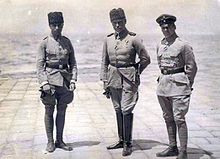Hans-Joachim Buddecke
Hans-Joachim Buddecke | |
|---|---|
Military Order of Saint Henry; Turkish Golden Liakat Medal and Gold and Silver award of the Imtiaz Medal |

Hans-Joachim Buddecke (22 August 1890 – 10 March 1918) was a German flying ace in World War I, credited with thirteen victories. He was the third ace, after Max Immelmann and Oswald Boelcke, to earn the Blue Max (Pour le Mérite). He saw combat in three theaters during the First World War: Bulgaria, Turkey, and the Western Front.[1] His exploits at Gallipoli arena won him the nickname El-Schahin, "hunter falcon".[2]
Background
Buddecke was born in Berlin and followed his father's footsteps into the Army.
Involvement in World War 1
Buddecke was sent to the
Buddecke scored his and the new unit's first victory on 19 September 1915; a B.E.2c of No 8 Squadron RFC, crewed by pilot Lt WH Nixon and observer Capt JNS Stott. Opening fire from 200 meters he disabled the observer's machine gun, although Captain Stott then returned fire with a pocket pistol. It was shot out of his hands at a range of ten meters and Nixon was hit. Buddecke's gun then jammed when its cartridge belt tore in the slipstream. As Buddecke struggled with the jammed gun, Stott clambered atop the shoulders of his dying pilot, set his heels on the pilot's knees to operate the rudder and bent forward to grab the controls. Buddecke cleared his gun and aimed at the British observer's yellow leather coat. The BE.2c crash landed near Saint-Quentin. Buddecke drove to the wreck after landing, where the uninjured captive Stott showed him the bullet holes in his coat.[9] Buddecke followed this up with confirmed claims on 23 October (a B.E.2 of No. 13 Squadron RFC, with Capt. CH Marks and Lt. WG Lawrence, the brother of TE Lawrence of Arabia. Both were killed) and 11 November and an unconfirmed victory on 6 December 1915.[1]

He was then sent to Gallipoli to fly the Halberstadt D.II and Fokker E.III with Ottoman FA 6 against the Royal Naval Air Service. The Turkish campaign was successful, with four confirmed victories and seven unconfirmed, and Buddecke was personally awarded the Gold Liakat Medal by Enver Pasha. He was recalled to the Western Front in late August 1916 as leader of the newly formed Royal Prussian Jagdstaffel 4.
After three kills during September, he again left for Turkey to fly with Ottoman FA 5. By early 1918 he was back in France with Royal Prussian

Within a few days Buddecke was killed during an aerial combat above
Decorations and awards
- Iron Cross of 1914, 1st and 2nd class (1915)
- Knight's Cross of the Royal House Order of Hohenzollern with Swords
- Knight's Cross of the Military Order of St. Henry
- Gold Liakat Medal (1916)
- Pour le Mérite (14 April 1916)
- Imtiaz Medal
Notes
- ^ a b c d e Above the Lines: The Aces and Fighter Units of the German Air Service, Naval Air Service and Flanders Marine Corps 1914 - 1918. pp. 88–89.
- ^ "Aegean Air War: Brinsmead's unfortunate distinction".
- ^ Early German Aces of World War I. p. 17.
- ^ Early German Aces of World War I.
- ^ Gray, Carroll (2005). "CICERO FLYING FIELD - Origin, Operation, Obscurity and Legacy - 1891 to 1916". lincolnbeachey.com. The Pioneer Aviation Group. Retrieved April 8, 2017.
SCHOOLS, PASSENGERS & BUSINESSES: Aviation schools were also located at Cicero Flying Field. Especially noteworthy were the Lillie Flying Station and School (later the Lillie-Thompson school), where Katherine Stinson learned to aviate, the National School, and the Partridge-Keller school. Many of the era's most notable aviators, such as Lincoln Beachey, Roy Francis, Fred Hoover, and William "Billy" Robinson, as well as a fair number of european aviators, spent time flying and learning to fly there. French citizens George Mestach, Andre Ruehl, Eugene Godet, Andre Frey, and Marcel Tournier, Russian citizens Ignace G. Semeniouk and Pavel "Paul" Studensky, J. Ramon Montero of Peru, and Hans-Joachim Buddecke of Germany flew at Cicero.
- ^ Gray, Carroll (2005). "CICERO FLYING FIELD - Origin, Operation, Obscurity and Legacy - 1891 to 1916". lincolnbeachey.com. The Pioneer Aviation Group. Retrieved April 8, 2017.
1914 - 1914 - BEACHEY & ROYALTIES: On May 20, Hans-Joachim Buddecke flew "Billy" Robinson's Gnome-powered Nieuport-type monoplane and apparently enjoyed the experience, for he purchased it from Robinson. He flew the monoplane at Cicero on several occasions from late May to early July, when he had an accident while landing. Buddecke came to Chicago from Germany to work with his uncle; at Cicero he learned to fly aeroplanes. In August 1914, as war began to rage in Europe, Hans-Joachim Buddecke returned to Germany with his Nieuport-type monoplane, and joined the Imperial German Air Service.
- ^ Early German Aces of World War I. p. 18.
- ^ a b van Wyngarden, Early German Aces, p.18
- ^ Early German Aces of World War I. p. 19.
- ^ Above the Lines: The Aces and Fighter Units of the German Air Service, Naval Air Service and Flanders Marine Corps 1914 - 1918. p. 88.
- ^ The Aerodrome website's page on Buddecke http://www.theaerodrome.com/aces/germany/buddecke.php Retrieved on 12 April 2010.
References
- van Wyngarden, G (2006). Early German Aces of World War I, Osprey Publishing Ltd. ISBN 978-1-84176-997-4
- Franks, Norman L. R., et al.Above the Lines: The Aces and Fighter Units of the German Air Service, Naval Air Service and Flanders Marine Corps 1914 - 1918 Grub Street, 1993. ISBN 978-0-948817-73-1
